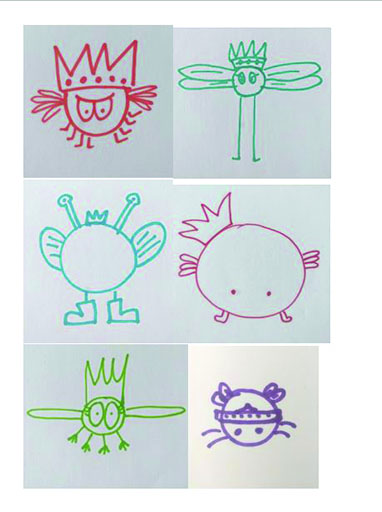3.2 Try out unplugged computing
In the next activity, you will try an unplugged activity for yourself. It has been adapted from the Barefoot Computing Company activity Crazy Character Algorithms (Barefoot Computing, 2014a) and is aimed at introducing algorithms to young children.
Activity 4 Going ‘unplugged’
You are going to be asked to follow a set of instructions from an illustrator to draw a particular game character. Carry them out by yourself, without consulting others.
- Draw a circle for the body
- Add two eyes
- Add a crown
- Add wings
- Add legs
Answer
Look at what you have drawn. Now look at some examples of what others drew following the same instructions.
What aspects of computing does this activity touch upon? What teaching points might the difference in the pictures highlight?
Discussion
These instructions are an example of an algorithm, albeit a poorly written one. The instructions are unclear and open to interpretation, so it is unlikely they were evaluated effectively before use. Whilst all the drawing were created following the same set of instructions, the ‘outputs’ vary. Questions about whether this variation is acceptable could be explored. If the illustrator wrote the instructions to help draw a specific character it is likely they had something particular in mind. The children could be asked to refine the algorithm, test it out, evaluate it and refine it again.
Unplugged activities help children to develop a mental model of how technology works. They will recognise the need for instructions to be clear and precise, at the appropriate level of detail and sufficiently flexible to deal with different but related situations. The focus is on developing an understanding that computing is about logical and creative problem solving. In such activities, children develop their ability to talk about how they are applying computational thinking skills to devise workable solutions. They use their existing knowledge of a system to predict future behaviours. Exploring these concepts in a relatable context, such as making a sandwich or drawing a picture, can be a good way of introducing concepts to children before introducing them to programming software.

